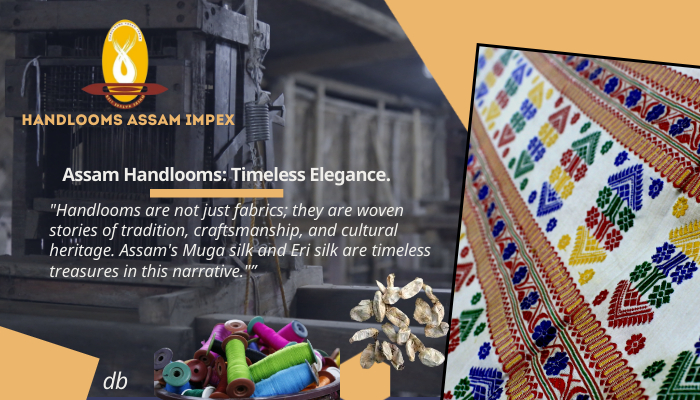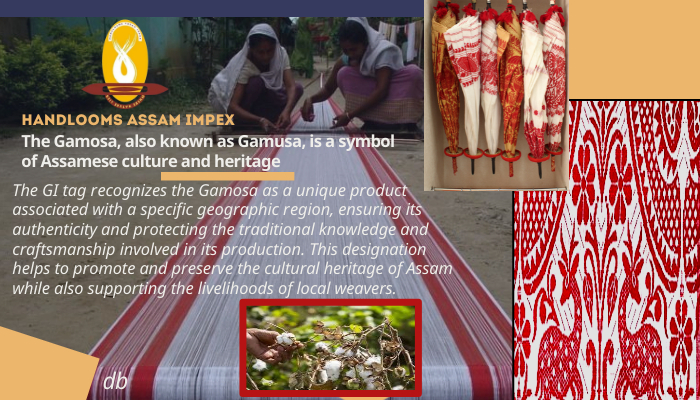
Assam Handlooms: Timeless Elegance
22-05-2024
Heritage of Assam Handlooms Assam, a land of rich cultural heritage, is renowned for its exquisite handloom fabrics that exude timeless elegance. From the banks of the Brahmaputra River to the lush tea gardens, the intricate artistry of Assam handlooms weaves together old stories with contemporary flair, creating a tapestry of tradition and innovation. Rooted in centuries-old weaving techniques passed down through generations, Assam handlooms have evolved to embrace modern designs while preserving their authenticity. The journey from traditional motifs to contemporary patterns reflects the resilience and adaptability of Assamese artisans, who infuse each fabric with pride and craftsmanship. The allure of Assam handlooms lies not only in their aesthetic appeal but also in their significance to the cultural identity of the region. Muga silk, with its natural golden hue, and Eri silk, known for its softness and durability, stand as symbols of luxury and tradition. Each thread tells a story of dedication, skill, and reverence for age-old customs. In recent years, initiatives such as the GI tagging of Assam handloom products, including the iconic Gamosa, have further enhanced their recognition and value on the global stage. The GI tag not only protects the authenticity of these handcrafted treasures but also promotes fair trade practices, empowering local artisans and ensuring sustainable livelihoods. As we celebrate the timeless elegance of Assam handlooms, it's essential to acknowledge the pivotal role of organizations like Handlooms Assam Impex in promoting and preserving this rich legacy. Their commitment to quality, innovation, and ethical practices has propelled Assam handlooms onto the international fashion scene, making them a symbol of pride for the entire nation. In a world dominated by mass-produced textiles, Assam handlooms stand apart as beacons of tradition, elegance, and sustainability. As we embrace the old stories woven into each fabric, let us also celebrate the new chapters being written by the skilled hands of Assamese weavers, ensuring that the legacy of timeless elegance continues to flourish for generations to come. The handloom industry in Assam traces its roots back to ancient times, deeply intertwined with the rich cultural fabric of the region. Historically, weaving has been a traditional craft practiced by various indigenous communities in Assam for centuries. The earliest evidence of handloom weaving in the region can be found in archaeological discoveries dating back to the prehistoric period. The advent of silk weaving in Assam can be attributed to the Ahom dynasty, which ruled the region for several centuries. Under their patronage, silk production flourished, with royal support for the cultivation of silk cocoons and the development of intricate weaving techniques. The Ahom rulers played a significant role in promoting silk weaving as a means of livelihood for local communities, laying the foundation for the flourishing silk industry that exists in Assam to this day. Over the centuries, Assam's handloom industry has evolved and diversified, incorporating a wide range of traditional techniques and designs. Each ethnic community in the region has its own unique weaving traditions, contributing to the rich tapestry of Assamese handloom textiles. From the intricate designs of Muga silk to the soft textures of Eri silk, each fabric reflects the cultural identity and heritage of the artisans who create them. In recent years, efforts have been made to revive and promote the handloom sector in Assam, recognizing its cultural significance and economic potential. Government initiatives, along with the support of NGOs and private organizations, have been instrumental in providing training, infrastructure, and market linkages to handloom weavers across the state. Additionally, the recognition of GI tags for iconic Assamese handloom products, such as the Gamosa, has helped protect their authenticity and promote them on a global scale. Today, the handloom industry continues to be a vital source of livelihood for thousands of artisans and weavers in Assam, preserving age-old traditions while adapting to modern market demands. With growing awareness and appreciation for handcrafted textiles, the future looks promising for Assam's handloom industry, ensuring that its rich legacy will endure for generations to come. The handloom weaving tradition in Assam is widespread, with several districts known for their unique contributions to this rich cultural heritage. Key districts and places where Assam handlooms are actively woven and produced include: Sualkuchi: Often referred to as the "Manchester of Assam," Sualkuchi is one of the most prominent weaving centers in Assam. Located in the Kamrup district, it is renowned for its production of high-quality Muga, Eri, and Pat silk. The weavers in Sualkuchi are famous for their intricate designs and fine craftsmanship. Guwahati: As the largest city in Assam, Guwahati is not just a commercial hub but also a significant center for handloom products. The city hosts several markets and exhibitions showcasing traditional Assamese handloom fabrics. Nagaon: This district is known for its production of traditional Eri silk, also known as "Ahimsa silk" due to its non-violent method of production. Nagaon weavers are adept at creating beautiful shawls, scarves, and other garments. Jorhat: Known as the cultural capital of Assam, Jorhat is another key district for handloom weaving. It has a rich tradition of producing fine Muga and Pat silk fabrics, often used in traditional Assamese attire like Mekhela Chadors. Dhemaji: Located in the northern part of Assam, Dhemaji is known for its production of Eri silk. The weavers in this district specialize in creating warm and durable Eri silk textiles. Dibrugarh: This district, located in Upper Assam, is also notable for its handloom products, especially silk fabrics. The weavers here contribute significantly to the state's silk industry. Barpeta: This district is famous for its production of traditional Assamese Gamosas and other handloom items. The weavers in Barpeta are skilled in creating various handloom products that hold cultural significance. Golaghat: Known for its exquisite handloom products, Golaghat district also contributes significantly to Assam's weaving industry. The weavers here produce beautiful silk and cotton fabrics. Sivasagar: Rich in history and culture, Sivasagar is known for its high-quality Muga silk production. The weavers in this district maintain traditional weaving techniques while also incorporating contemporary designs. These districts and places are vital to Assam's handloom industry, each contributing their unique styles and techniques to the rich tapestry of Assamese textiles. The weavers in these areas continue to uphold and innovate their craft, ensuring the preservation and growth of Assam's handloom heritage.
- Assam handlooms stand apart as beacons of tradition, elegance, and sustainability.

